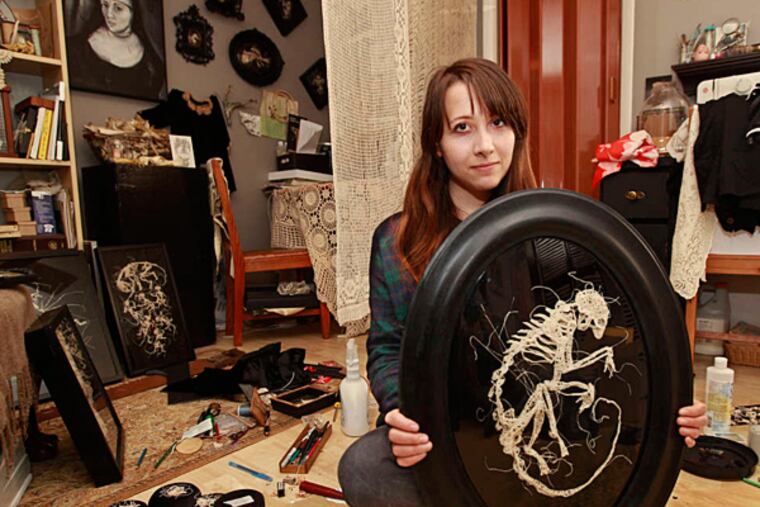Philadelphia artist experiments with the threads of memory
In a room full of skeletons, Caitlin McCormack needs the quiet company of other living things - potted succulents, for instance, perched along the windowsill of her South Philadelphia studio.

In a room full of skeletons, Caitlin McCormack needs the quiet company of other living things - potted succulents, for instance, perched along the windowsill of her South Philadelphia studio.
They're not real skeletons, of course, curled up like leaves on black velvet and transfixed beneath glass. McCormack, a 27-year-old University of the Arts graduate, crochets them from supplies inherited from her grandmother to make small, delicate works of art.
McCormack began this body of work when her grandparents died within months of each other in late 2010 and early 2011. After studying illustration during her undergraduate years, McCormack returned to the familiar process of crocheting to deal with her grief. Her grandmother taught her how to crochet as a child; her grandfather was a skilled woodworker, creating lifelike birds.
The first creature McCormack made was a synthesis of the two: a bird skeleton made from tiny crochet stitches. The skeletal remains expressed her loss and the diminishing bloodline of her small family.
Since then, Philadelphia galleries such as Arch Enemy Arts and the Painted Bride Art Center have featured her work, as well as Brooklyn's Stephen Romano Gallery and Chelsea's ArtNowNY. McCormack has two forthcoming shows, one opening June 5 at the Art Dept in Fishtown, and another in October at the Paradigm Gallery, where some of her work is currently available for purchase online.
At Arch Enemy Arts, visitors are often struck by McCormack's work, said co-owner Patrick Shillenn. People dwell on the intricately crocheted skeletons, he said, "for a noticeably long time."
Maybe they're looking for something.
"Her design is made from negative space," said Kate Glasheen, exhibits director at the Art Dept. "But I think it's more about the space that's missing. That void is what speaks to me the most."
The skeletons, which McCormack sells for between $60 and $800, tell stories of loss, asking viewers to confront their own personal emptiness. To create each piece, which can take anywhere from two days to several weeks, McCormack focuses on a specific memory of her own, and begins to crochet a skeleton without reference. As a medium, crochet "accelerates the process of forgetting" with its physical "twisting and warping," she said.
The final products aren't supposed to be replicas, but are more like metaphors for the artist's memories. The middleman between the real thing and the metaphor, McCormack said, is missing. Gone. Removed.
"I've always been fixated on loss," McCormack said. "It's a thing I can't get over. Not missing a person, necessarily, but regret. Not having said certain things. Bad timing. Those are very perplexing to me."
McCormack's mother, Joan, said her daughter first started making things in a cabin in the New Jersey woods, where the family lived until McCormack was about 10. She and her husband, Brian, did not have much money, and it could get lonely for an only child without other kids to play with.
"She had a dollhouse, but none of the furniture or dolls to go with it," her mother said. "So she would make all these little figures, and chairs and clothes for them."
Some of the artist's earliest memories are from that house and those woods. One memory in particular has stayed with her: car rides through "those ubiquitous New Jersey highway roadsides when the sun is setting." McCormack was entranced by the darkness, and her eventual decision to mount her work onto black velvet came directly from this memory.
That these are McCormack's own recollections innately creates intimacy, said Sara McCorriston, co-owner of the Paradigm Gallery, and it allows viewers to feel as though they're learning about the artist.
"It's so personal, and you're so thankful," McCorriston said, "because it's like she's sharing a secret with you."
When Natasha Gitlitz of Dallas first saw McCormack's work, she was stunned by the crocheting technique, completed without a pattern. Drawn in by the "dark skulls" and "light, feminine fabric of the crocheting," Gitlitz knew she had to make McCormack's work one of her "first pieces of real art," she said.
Gitlitz bought two pieces from Arch Enemy Arts in 2014. Not a day goes by, Gitlitz said, that she doesn't stop to appreciate McCormack's work, hanging at the top of her stairs.
"So they're the first things I see when I walk in," Gitlitz said.
McCormack said she's still evolving as an artist, and hopes to eventually create larger pieces of work, with doilies, fabrics, and string sourced from estates or collections. Then she can meld her own memories to the objects with "fabricated nostalgia."